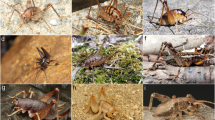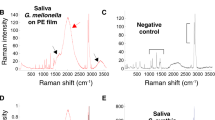Abstract
WHILE examining some grain infected with tyroglyphid mites, I found a specimen of Cheletomorpha lepidoptorum Shaw (=venustissima Berlese), which had just finished laying eggs. About six eggs were scattered on the ground, and the Cheletomorpha was moving backwards and forwards, covering them with a sparse network of silk. In this mite, the mouth is at the end of a gnathosoma, which is shaped like a cone and completely encircles the cheliceral stylets. The silk was coming from the mouth in the form of a very fine thread, which was stretched from side to side over the eggs, the pedipalpal claw being used for manipulating it at times. Unlike Cheyletus eruditus Schrank, which remains crouched over its eggs until the larvæ emerge, the Cheletomorpha took no further interest in the welfare of its young, but wandered away to lay a few more eggs in another place.
This is a preview of subscription content, access via your institution
Access options
Subscribe to this journal
Receive 51 print issues and online access
$199.00 per year
only $3.90 per issue
Buy this article
- Purchase on Springer Link
- Instant access to full article PDF
Prices may be subject to local taxes which are calculated during checkout
Similar content being viewed by others
Author information
Authors and Affiliations
Rights and permissions
About this article
Cite this article
HUGHES, A. Silk Production in the Cheyletidae (Acarina: Arachnida). Nature 180, 815–816 (1957). https://doi.org/10.1038/180815b0
Issue Date:
DOI: https://doi.org/10.1038/180815b0
Comments
By submitting a comment you agree to abide by our Terms and Community Guidelines. If you find something abusive or that does not comply with our terms or guidelines please flag it as inappropriate.



